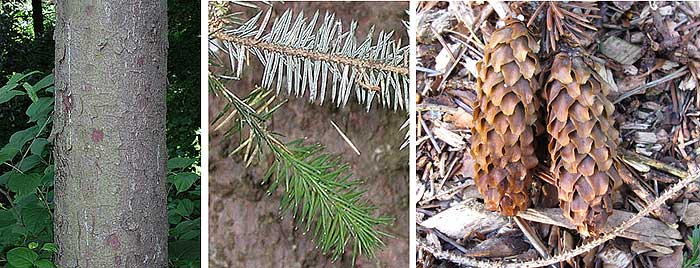The Trees at Keele
Sitka Spruce Picea sitchensis

Origin: Found on the 2100 mile coastal belt from northern California to south-east Alaska, the Sitka Spruce is adapted to deal with a very moist environment. The tiny pores where the gas-exchange takes place, called stomata, can typically be opened and closed to prevent desiccation in most trees. The Sitka Spruce cannot close these pores, and therefore can only flourish in moist environments, where the humidity remains relatively stable and high.
As the largest species of spruce, the largest specimens can be found in the temperate rain forest valleys Washington State and British Columbia, reaching sizes of over 20 meters in circumference and over 90 meters tall.
Native uses of this species included using its flexible roots to weave with, as well as using its strong wood as a resource for tools. During the early to mid 20th century the sitka spruce was in high demand for its light but strong wood to build planes, and is still regarded as a prize lumber species now grown in many parts of the world, including Scotland. Contributed by Erik J. Wilson.
It was introduced to the UK in 1831 and is one of those trees that one either loves or hates. Because of it liking for damp conditions and its fast growth, it has become the tree of choice for foresters in the wetter parts of the UK. It has been wideley planted in upland areas where the monoculture blocks of trees upset the conservationists and wilderness lovers! Despite all that, it is rather an attractive tree.
Bark: The trunk is straight as a die, the bark cracks into lifting scales or plates - shown clearly in the picture. The bark of the Norway Spruce is smooth. In shape it is narrowly conic with a long spire, the branches ascending but then arching over.
The needles are sharp, short, dark green and shiny above but with two broad pale lines below, giving it a bluish colour at a distance. In Norway Spruce - the familiar Christmas tree - the needles are green on both sides and not sharp.
The cones of 5-8cm long, with pale brown papery scales which have crinkly, toothed margins.
Uses: Particular good for paper making but is also used in making pallets, for building and for various types of board.
At Keele : a few between Keele Hall and the ring-road in square N9 and some in the plantations near the motorway.

